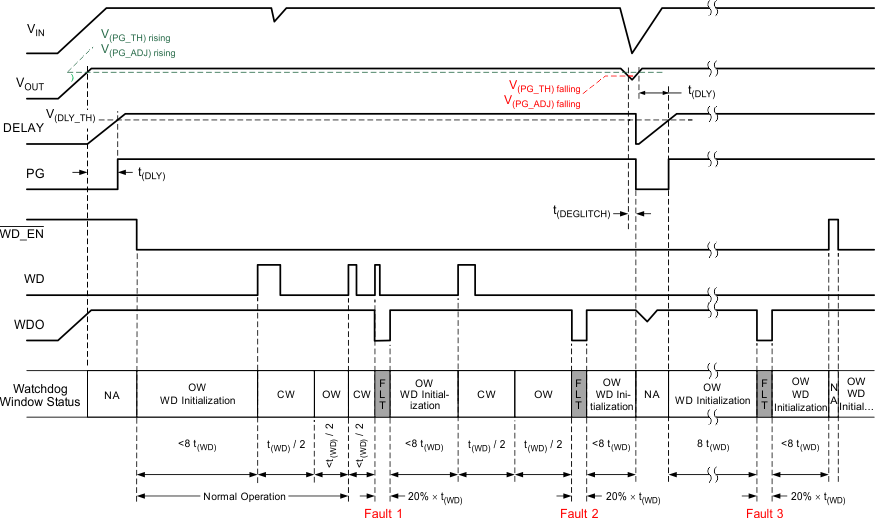ZHCSG47C February 2017 – December 2022
PRODUCTION DATA
- 1 特性
- 2 应用
- 3 说明
- 4 Revision History
- 5 Pin Configuration and Functions
- 6 Specifications
-
7 Detailed Description
- 7.1 Overview
- 7.2 Functional Block Diagram
- 7.3
Feature Description
- 7.3.1 Device Enable (EN)
- 7.3.2 Adjustable Power-Good Threshold (PG, PGADJ)
- 7.3.3 Adjustable Power-Good Delay Timer (DELAY)
- 7.3.4 Undervoltage Shutdown
- 7.3.5 Current Limit
- 7.3.6 Thermal Shutdown
- 7.3.7
Integrated Watchdog
- 7.3.7.1 Window Watchdog (WTS, ROSC, FSEL and WRS)
- 7.3.7.2 Standard Watchdog (WTS, ROSC and FSEL)
- 7.3.7.3 Watchdog Service Signal and Watchdog Fault Outputs (WD and WDO)
- 7.3.7.4 ROSC Status Detection (ROSC)
- 7.3.7.5 Watchdog Enable (PG and WD_EN)
- 7.3.7.6 Watchdog Initialization
- 7.3.7.7 Window Watchdog Operation (WTS = Low)
- 7.3.7.8 Standard Watchdog Operation (WTS = High)
- 7.4 Device Functional Modes
- 8 Application and Implementation
- 9 Device and Documentation Support
- 10Mechanical, Packaging, and Orderable Information
7.3.7.7 Window Watchdog Operation (WTS = Low)
The window watchdog is able to monitor whether the frequency of the watchdog service signal (WD) is within certain ranges. A watchdog low-voltage fault is reported when the frequency of the watchdog service signal is out of the setting range. Figure 7-4 shows the window watchdog initialization and operation for the TPS7B63xx-Q1 (WRS is low). After the output voltage is in regulation and PG is high, the window watchdog becomes enabled when an external signal pulls WD_EN (the watchdog enable pin) low. This causes the watchdog to initialize and wait for a service signal during the first initialization window for 8 times the duration of t(WD). A service signal applied to the WD pin during the initialization open window resets the watchdog counter and a closed window starts. To prevent a fault condition from occurring, watchdog service must not occur during the closed window. Watchdog service must occur during the following open window to prevent a fault condition from occurring. The fault output (WDO), externally pulled up to VOUT (typical), stays high as long as the watchdog receives a proper service signal and there is no other fault condition.
 Figure 7-4 Window Watchdog
Operation
Figure 7-4 Window Watchdog
OperationThree different fault conditions occur in Figure 7-4:
- Fault 1: The watchdog service signal is received during the closed window. The WDO is triggered once, receiving a WD rising edge during the closed window.
- Fault 2: The watchdog service signal is not received during the open window. WDO is triggered after the maximum open-window duration t(WD) / 2.
- Fault 3: The watchdog service signal is not received during the WD initialization. WDO is triggered after the maximum initialization window duration 8 × t(WD).